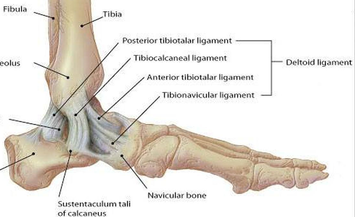Introduction
The Deltoid ligament (or the medial ligament of talocrural joint) is a strong, flat and triangular band. It is attached above to the apex and anterior and posterior borders of the medial malleolus. The Deltoid ligament is composed of superficial and deep components.
The superficial components:
- The tibiocalcaneal ligament,
- The tibionavicular ligament
- The posterior superficial tibiotalar ligament
- The tibiospring ligament
The deep components:
- The anterior tibiotalar ligament (ATTL)
- The posterior deep tibiotalar ligament (PDTL)
Clinically Relevant Anatomy
The deltoid ligament attaches the medial malleolus to multiple tarsal bones. Unlike the superficial layer of this ligament, the deep layer is intraarticular and is covered by synovium. Anatomically, in general, the superficial components arise from the anterior colliculus of the medial malleolus, and the deep components arise from the intercollicular groove (malleolar groove) and the posterior colliculus of the medial malleolus.
The superficial deltoid originates from the anterior & inferior aspects of medial malleolus fanning out & sending 3 bands to navicular and along plantar calcaneonavicular (spring) ligament, to sustenaculum tali of calcaneus and to medial tubercle. It is also partially covered by tendon sheaths & crural fascia. It primarily resists eversion of hindfoot; Tibionavicular portion suspends spring lig & prevents inward displacement of head of talus, while tibiocalcaneal portion prevents valgus displacement.
The deep deltoid originates on posterior border of anterior colliculus, intercollicular groove, & posterior colliculus. It is oriented transversely & inserts into the entire nonarticular surface of medial talus. Deep deltoid extends the function of the medial malleolus, prevents lateral displacement of talus & prevents external rotation of the talus (this is mostly significant in plantar flexion, when deep deltoid tends to pull talus into internal rotation).
Medial ankle stability is provided by the strong deltoid ligament, the anterior tibiofibular ligament and the bony mortise. Because of the bony articulation between the medial malleolus and the talus, medial [1][2]
Isolated deltoid ligament injuries are extremely rare and usually occur in combination with [3]
Physical Examination
Eversion Test-
In neutral evaluates superficial deltoid ligament complex.
External rotation stress test evaluates syndesmotic ligaments and additionally – the deep deltoid ligament;
Radiographic Diagnosis of Injury
Deloid is usually avulsed from tibial attachment, frequently w/ small flake of bone visible on x-rays;
– disruption of deltoid ligament can be dxed w/ relative confidence when medial clear space between talus & med malleolus is increased;
– lateral shift of talus, w/ incr medial joint space ( > 3 mm), but this may be apparent only on stress view or in postcasting films, after swelling has subsided;
– presence of medial tenderness & > 5 mm of space is seen then there is substantial injury of deltoid ligament;
Treatment of Deltoid Tear
– such injuries should be rxed as bimalleolar frx, w/ ORIF of lateral malleolus;
– routine exploration of medial side of ankle is not necessary unless there is evidence that portion of deltoid lig has entered joint & is blocking reduction of talus
Physical Therapy Management
To avoid [4](level of evidence 2A)
This exercise can also be done without the resistance of a physiotherapist. The subject takes place on a chair. He puts an elastic tubing around his foot, and puts his other foot on the elastic tubing. He holds the elastic tubing in his contralateral hand. Then he has to perform the same exercise as with the therapist. He has to push his foot outward, with his footpad away from the midline of his body.
We can start exercises for proprioception after 5 weeks when started physiotherapy.
Exercise for training the proprioception, the double-leg right/left condition, the subjects had to sit on a chair, with their feet on a kinaesthetic ankle board. They had to keep their knees at a 90° angle, while maintaining contact with the top of the KAB with their respective extremities. Then they had to rotate the board to the left side and then back to the right (=clockwise and counter clockwise). The subjects had to keep the side of the board in the floor each time they moved the board to the left or the right. Each exercise had to be done 3×25 times. [5](level of evidence 2B)
The next exercise had to be done in stance. First they had to stand flat floor and then on a balance board. The subjects had to stand on one leg on the floor, first with their eyes open and thereafter with their eyes closed. Each exercise had to be done 3×15 times. After this exercise the subject had to stand with both feet on a balance board or wobble board. They had to make circular movements to train eversion, but also inversion, dorsiflexion and plantar flexion.
The next exercise was the same as the first one, but now the subject had to stand on the balance board. They were instructed to stand on one leg in the middle of the balance board, and then they had to maintain the stance on the balance board. First they had to do it with their eyes open, thereafter with their eyes closed. Each exercise was performed during 30 seconds. [6](level of evidence 2B)
To make these exercises more difficult we could vary the surfaces, on the floor, a balance board, and an instable underground. Another way to increase the difficulty was to open or close the eyes while performing the exercises. The physiotherapist could also increase the exercise by giving light perturbations while the subject balanced on the balance board.
Refrences
- ↑ Wolfe MW, Uhl TL, Mattacola CG, McCluskey LC. Management of ankle sprains. Am Fam Physician. 2001 Aug 1;64(3):386. (level of evidence 3A)
- ↑ Wolfe MW, Uhl TL, Mattacola CG, McCluskey LC. Management of ankle sprains. Am Fam Physician. 2001 Aug 1;64(3):386. (level of evidence 3A)fckLRUrl: ↑ Brand RL, Collins MD. Operative management of ligamentous injuries to the ankle. Clin Sports Med. 1982 Mar;1(1):117-30.
- ↑ Carl G. Mattacola et al, Rehabilitation of the ankle after acute sprain or chronic instability, Journal of Athletic Training, 2002 (level of evidence 2A)
- ↑ Carl G. Mattacola et al, Effects of a 6-week strength hand proprioception training program on measures of dynamic balance: a single-case design, Journal of Athletic Training, 1997 (level of evidence 2B)
- ↑ K. Söderman et al, Balance board training: prevention of traumatic injuries of the lower extremities in female soccer players, Knee Surgery, Sports Traumatology, Arthroscopy, 2000 ((level of evidence 2B)




